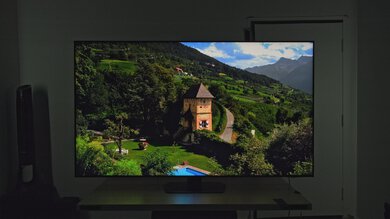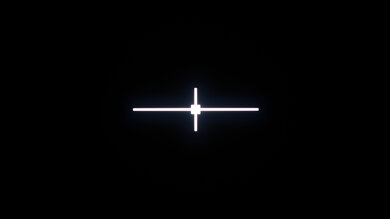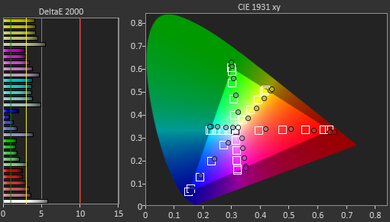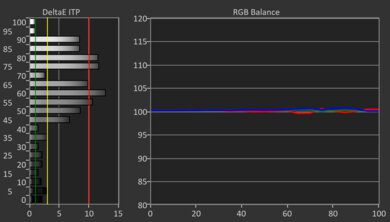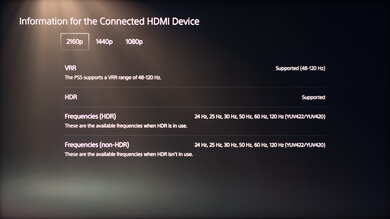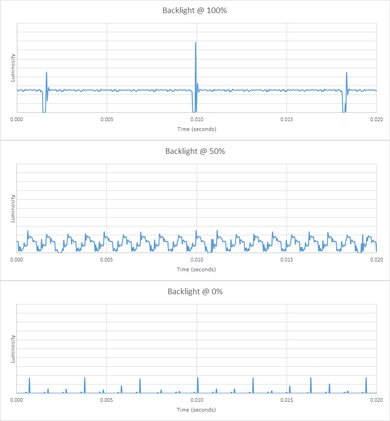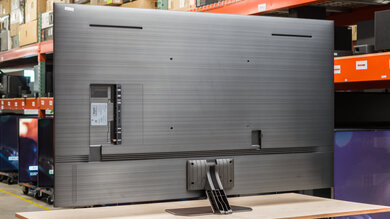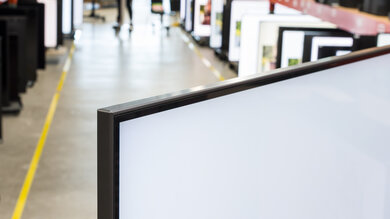The Samsung QN90D/QN90DD QLED is an upper mid-range 4k TV released in 2024. It replaces the Samsung QN90C/QN90CD QLED and sits above the Samsung QN85D/QN85DD QLED and below the Samsung QN95D QLED. It uses Samsung's Neo Quantum 4k AI Gen 2 processor, designed to improve performance and deliver better overall picture quality than its predecessor. The TV has 60W 4.2.2CH speakers built-in, uses the 2024 version of Samsung's Tizen OS, and is available in seven sizes: 43-inch, 50-inch, 55-inch, 65-inch, 75-inch, 85-inch, and a massive 98-inch model. Unlike the QN90C, which only had 144Hz support on the two smallest size options, this TV supports 144Hz on all sizes except for the 98-inch model.
Our Verdict
The Samsung QN90D is great for mixed usage. It's excellent for watching content in a bright room, like sports, due to its superb SDR brightness, very good color volume, and decent direct reflection handling, and it also looks amazing in a dark room due to its ability to display deep blacks. Watching content in HDR is impactful due to the TV's outstanding HDR brightness, although, unfortunately for gamers, the TV loses quite a bit of its vibrancy in Game Mode; it's still decent, but it's definitely dimmer. Its pixel transitions are also quite slow, so it doesn't deliver a truly motion blur-free experience when gaming, although it's still responsive enough due to its low input lag and VRR support. Finally, its image processing excels when upscaling SD content, making it a great choice to pair with your old DVDs or when watching SD feeds on cable.
Excellent black levels with little blooming.
Excellent HDR brightness for impactful highlights.
Decent enough direct reflections handling for a bright room.
Truly superb SDR brightness.
Colors are bright and vibrant, especially in HDR.
Loses a lot of its HDR brightness in Game Mode.
Slow pixel transitions in Game Mode leads to blurry motion.
The Samsung QN90D is great for a home theater setup. It has excellent black levels, so blacks are deep in dim and dark scenes, and they stay that way when bright highlights are present. It performs admirably well when upscaling SD content, leaving you with a clean-looking image. It also respects the content creator's intent well. It doesn't perform quite as well in low-bitrate situations, so movies streamed from online platforms have some visible macro-blocking, but it's not excessive. There's also some stutter due to the TV's fast response time, but it's not egregious enough to bother most people. Unfortunately the TV doesn't support the popular Dolby Vision HDR format, instead opting for the less widely used HDR10+, and it also doesn't pass through advanced DTS audio formats through eARC.
Excellent black levels with little blooming.
Excellent HDR brightness for impactful highlights.
Impressive low-resolution upscaling.
Tracks the content creator's intent well in HDR due to its good PQ EOTF tracking
Colors are bright and vibrant, especially in HDR.
No Dolby Vision or DTS audio support.
Only passable pre-calibration SDR accuracy.
Okay low-quality content smoothing, but it does leave some compression artifacts in the feed.
The Samsung QN90D is excellent for use in a bright room. It has superb SDR brightness and decent handling of direct reflections, although lamps or windows opposite the TV are visible on the screen. On the other hand, it does a good job of retaining color vibrancy in a bright room, and although black levels do rise in a bright room, blacks remain deep enough that the image doesn't look too washed out.
Decent enough direct reflections handling for a bright room.
Truly superb SDR brightness.
Colors are bright and vibrant, especially in HDR.
Black levels are not quite as deep in brighter rooms.
The Samsung QN90D is great for watching sports. This TV is extremely bright in SDR, and its direct reflection handling is decent enough to overcome some glare in a bright room. Colors in your favorite sports are nice and colorful thanks to the TV's good color volume in SDR, although their accuracy is only passable. You get a clean-looking image when watching SD content due to the TV's impressive low-resolution upscaling. The TV's viewing angle is satisfactory; the image degrades when viewed from more aggressive angles, but overall, it's a decent choice for a large gathering. Unfortunately, the TV's gray uniformity isn't the best, so you do see some dirty screen effect when watching sports with large areas of uniform color, but it's not excessive and isn't likely to distract most viewers.
Impressive low-resolution upscaling.
Decent enough direct reflections handling for a bright room.
Truly superb SDR brightness.
Colors are bright and vibrant, especially in HDR.
Some noticeable dirty screen effect towards the center of the screen.
Only passable pre-calibration SDR accuracy.
Okay low-quality content smoothing, but it does leave some compression artifacts in the feed.
The Samsung QN90D is good for gaming. It has excellent black levels with little visible blooming, with vibrant colors that pop in HDR. The TV has HDMI 2.1 bandwidth on all four ports for up to 4k @ 144Hz gaming, with VRR. However, its pixel transitions are quite slow overall, so fast motion in games is blurry; stick to 120Hz for the best performance, as its response time is slower at 60Hz and 144Hz. It's also not nearly as bright in Game Mode as in its other picture modes; it's still bright enough for a decent visual experience, but it's a noticeable drop in visual fidelity.
HDMI 2.1 bandwidth on all four ports, all capable of up to 4k @ 144Hz with VRR support.
Very low input lag for a very responsive experience.
Colors are bright and vibrant, especially in HDR.
Loses a lot of its HDR brightness in Game Mode.
Slow pixel transitions in Game Mode leads to blurry motion.
The Samsung QN90D has outstanding brightness overall. It has superb SDR brightness, so it's more than capable of overcoming glare from indirect sources of light. It also has excellent HDR brightness, which makes highlights really pop in HDR content.
Excellent HDR brightness for impactful highlights.
Truly superb SDR brightness.
The Samsung QN90D has excellent black levels. It has incredibly effective local dimming, giving it amazing contrast and black uniformity with little blooming.
Excellent black levels with little blooming.
Black levels are not quite as deep in brighter rooms.
The Samsung QN90D has very good overall color performance. It has excellent color volume in HDR and good color volume in SDR, so it's quite colorful. Unfortunately, while its SDR pre-calibration accuracy is passable, purists won't be satisfied. Thankfully, it's more accurate in HDR, although home theater aficionados are still likely to want to calibrate their panel for the best possible experience.
Colors are bright and vibrant, especially in HDR.
Only passable pre-calibration SDR accuracy.
Note: We're in the process of improving our tests related to image processing, but this score should give you a general idea of how a TV performs overall with its image processing capabilities.
The Samsung QN90D's image processing is decent overall, albeit uneven. It upscales low-resolution content impressively well. It also does a good job of respecting the content creator's intent when it comes to HDR brightness. Its low-quality content smoothing is okay; it does clean up some compression artifacts, but there's a fair amount remaining in the feed. There's also some banding in HDR gradients, but it's not excessive.
Impressive low-resolution upscaling.
Tracks the content creator's intent well in HDR due to its good PQ EOTF tracking
Okay low-quality content smoothing, but it does leave some compression artifacts in the feed.
The Samsung QN90D is decently responsive in Game Mode, with its low input lag, support for a variety of VRR modes, and a large amount of supported resolutions. Unfortunately, its pixel transitions really aren't fast enough to provide a motion-blur free gaming experience, as there's noticeable motion blur in most scenes, especially at 60Hz and 144Hz; stick to 120Hz for the best performance.
HDMI 2.1 bandwidth on all four ports, all capable of up to 4k @ 144Hz with VRR support.
Very low input lag for a very responsive experience.
Slow pixel transitions in Game Mode leads to blurry motion.
We're in the process of fixing the way we evaluate a TV's overall motion handling. This section is currently broken, and the score isn't indicative of how well a TV handles motion overall.
Performance Usages
Changelog
-
Updated Jun 11, 2025:
We updated the Black Frame Insertion section after confirming that the TV only supports BFI at 60Hz.
-
Updated May 29, 2025:
We clarified that the 43" and 50" models aren't as bright as the larger sizes in the Differences Between Variants section.
- Updated May 08, 2025: Converted to Test Bench 2.0.1. We did this to fix an issue with our scoring in the Supported Resolutions section, since TVs with a refresh rate higher than 144Hz were being penalized for not supporting 144Hz.
-
Updated May 02, 2025:
We mentioned the newly reviewed Samsung QN90F in the HDR Brightness In Game Mode section of this review.
Check Price
Differences Between Sizes And Variants
We bought and tested the 65-inch Samsung QN90D, and these results are also valid for the 55-inch, 75-inch, and 85-inch models. Although most of our results should be applicable to the 43-inch and 50-inch models, those two sizes aren't as bright as the larger ones, and we don't know exactly how much dimmer they are. The 98-inch model is limited to a 120Hz refresh rate, but all other results should be the same. It's also sold as the Samsung QN90DD at some warehouse retailers, including Costco. The DD variant has slightly better speakers (70W vs. 60W on the QN90D) and a longer warranty, but otherwise performs the same. Note that the last five letters in the model number (AFXZA in this case) vary between retailers and individual regions, but there's no difference in performance.
In Canada, there's also the QN92D. It has 70W speakers instead of 60W, but outside of that, the TV performs the same.
| Size | US Model | Short Model Code | Costco Variant | Max Refresh Rate |
|---|---|---|---|---|
| 43" | QN43QN90DAFXZA | QN43QN90D | - | 144Hz |
| 50" | QN50QN90DAFXZA | QN50QN90D | - | 144Hz |
| 55" | QN55QN90DAFXZA | QN55QN90D | - | 144Hz |
| 65" | QN65QN90DAFXZA | QN65QN90D | QN65QN90DDFXZA | 144Hz |
| 75" | QN75QN90DAFXZA | QN75QN90D | QN75QN90DDFXZA | 144Hz |
| 85" | QN85QN90DAFXZA | QN85QN90D | QN85QN90DDFXZA | 144Hz |
| 98" | QN98QN90DAFXZA | QN98QN90D | - | 120Hz |
Our unit was manufactured in February 2024.
Popular TV Comparisons
The Samsung QN90D is a great TV overall. It delivers excellent picture quality and is loaded with modern features. It's a good option for gamers with modern consoles or gaming PCs due to its HDMI 2.1 bandwidth, VRR support, and up to 4k @ 144Hz, although its response time isn't quite good enough for a motion blur-free gaming experience. It's also quite pricey, and there are other similar TVs that perform similarly or better for less money. You can get the fully-featured Hisense U8/U8N and TCL QM8/QM851G QLED for cheaper. Both TVs offer a more impactful viewing experience, and they both support Dolby Vision alongside advanced DTS audio formats, both of which the Samsung doesn't support. If you instead need a TV that's more suitable for a wide seating arrangement and doesn't need all the brightness the QN90D offers, you can get the better overall Samsung S90D/S90DD OLED for around the same price.
For more options, check out our recommendations for the best QLED TVs, the best 4k gaming TVs, and the best TVs.
The Samsung QN90D and Samsung QN90F are extremely similar TVs, but, overall, the older QN90D has a very slight edge over its successor, mostly due to its noticeably better contrast and color vibrancy. For gamers, it's a wash: the QN90D loses a lot of its HDR brightness in Game Mode, and the QN90F doesn't, but inversely, the newer model has noticeably worse zone transitions in Game Mode, giving it worse black levels than its predecessor when gaming. PC gamers will, however, appreciate the QN90F's 165Hz support and slightly faster pixel transitions, although it's a minor improvement. The biggest advantage of the QN90F is its far better direct reflection handling due to its matte coating.
The Samsung QN90D is much better than the Samsung QN80F. The QN90D is a lot brighter in HDR, so small specular highlights stand out much better from the background, and very bright scenes are more impressive. The QN90D also has much better contrast and a significantly better local dimming system, so blacks are deeper, more uniform, and there's less haloing around bright lights or subtitles on a dark background.
The Samsung QN90D is better than the TCL QM7K. The Samsung is brighter, so specular highlights in HDR stand out better than they do on the TCL. The Samsung TV is also better at overcoming glare in a bright room, but there's a slight downside to it, as its black levels rise in a bright room, so it has worse contrast during the day.
The Samsung S90D OLED (QD-OLED) is better than the Samsung QN90D. The S90D displays deeper blacks in a dark room due to its nearly infinite contrast ratio, and there's no blooming. The S90D also has a much wider viewing angle, so no matter where you or your friends sit, you'll see a consistent image. The S90D really shines when it comes to colors, and its much wider color gamut displays incredibly vibrant and lifelike colors with no noticeable banding in color gradients. The S90D also has a faster response time, so there's no noticeable blur behind quick motion. The QN90D is the brighter TV overall, so it fights more glare in very bright rooms, but the S90D is also no slouch in that regard.

We buy and test dozens of TVs yearly, taking an objective, data-driven approach to deliver results you can trust. Our testing process is complex, with hundreds of individual tests that take over a week to complete. Most of our tests are done with specially designed test patterns that mimic real content, but we also use the same sources you have at home to ensure our results match the real-world experience. We use two main tools for our testing: a Colorimetry Research CR-100 colorimeter and a CR-250 spectroradiometer.
Test Results

The Samsung QN90D has amazing HDR brightness. Highlights really pop out during darker scenes, and the TV is bright enough that very bright specular highlights even stand out in well-lit scenes. Combined with its fantastic contrast, this TV provides a very impactful HDR viewing experience.
These measurements are after calibrating the HDR white point with the following settings:
- HDR Picture Mode: Filmmaker
- Brightness: 50
- Contrast: 50
- Contrast Enhancer: Off
- HDR Tone Mapping: Static
- Color Tone: Warm 2
- Color Space: Auto
- Peak Brightness: High
Results with HDR Tone Mapping set to 'Active':
- Hallway Lights: 1223 cd/m²
- Yellow Skyscraper: 1041 cd/m²
- Landscape Pool: 501 cd/m²
The Samsung QN90D is visibly dimmer when set to Game Mode. It's still bright enough for highlights to stand out during darker scenes and to provide an impactful HDR experience while gaming.
These measurements are after calibrating the HDR white point with the following settings:
- HDR Picture Mode: Game Mode
- Game HDR: Basic
- Brightness: 50
- Contrast: 50
- Contrast Enhancer: Off
- HDR Tone Mapping: Static
- Color Tone: Warm 2
- Color Space: Auto
- Peak Brightness: High
Results with 'HDR Tone Mapping' set to 'Active':
- Hallway Lights: 515 cd/m²
- Yellow Skyscraper: 644 cd/m²
- Landscape Pool: 136 cd/m²
Results with 'Game HDR Advanced' turned on:
- Hallway Lights: 748 cd/m²
- Yellow Skyscraper: 749 cd/m²
- Landscape Pool: 332 cd/m²
Look at the TCL QM8/QM851G QLED or Samsung QN90F if you want a similar TV that doesn't lose HDR brightness while using Game Mode.
The Samsung QN90D has superb SDR brightness and easily overcomes glare in even the brightest of rooms.
These measurements are after calibration with the following settings:
- Picture Mode: Movie
- Brightness: 50
- Color Tone: Warm 2
- Color Space: Auto
- Peak Brightness: High
- Gamma: 2.2
The Samsung QN90D has truly excellent contrast with local dimming on 'High.' The TV's native contrast ratio is mediocre, but its effective local dimming feature provides very deep blacks in a dark room, and they stay deep when bright highlights are also on screen. If you want a Samsung TV with even better contrast, check out the 2024 Samsung S85D OLED, or, if you're in the market for an 8k TV, the Samsung QN900D 8k QLED.
The TV has decent lighting zone transitions. Unfortunately, the leading edge of bright highlights when they quickly move across the screen is visibly dimmer, and there's very noticeable haloing.
The TV has good SDR color volume. It has impressive coverage of the commonly used DCI-P3 color space, although it can't quite fully display bright greens, yellows, and oranges, as well as some blues and cyans. The TV has mediocre coverage of the wider BT.2020 color space; its color volume isn't quite good enough to fully display most colors, with the exception of magentas.
| Volume ΔE³ | DCI-P3 Coverage |
BT.2020 Coverage |
|---|---|---|
| L10 | 89.53% | 68.50% |
| L20 | 90.95% | 68.54% |
| L30 | 91.08% | 68.49% |
| L40 | 91.21% | 70.51% |
| L50 | 91.62% | 71.30% |
| L60 | 91.45% | 68.84% |
| L70 | 91.54% | 59.41% |
| L80 | 92.03% | 57.02% |
| L90 | 89.53% | 56.55% |
| L100 | 71.56% | 58.75% |
| Total | 90.62% | 64.05% |
The TV has amazing HDR color volume. It displays a wide range of colors at high luminance levels, and dark, saturated colors are displayed well due to its excellent contrast.
The Samsung QN90D has passable pre-calibration accuracy. Gamma is close to our target of 2.2, but bright scenes are too bright, and dark scenes are a bit too dark. The TV's white balance is mediocre, with blues underrepresented in all shades of gray and reds overrepresented in brighter grays. The color temperature is much warmer than our target of 6500K, and most colors are inaccurate across the board.
The TV has fantastic SDR accuracy after calibration. Gamma, white balance, and color temperature are all nearly perfect. Color accuracy is much better now, but all colors are still a little bit off the mark.
You can see our full calibration settings.
The TV has decent pre-calibration accuracy in HDR. Its color accuracy is great, with only some reds and grays showing significant color mapping issues. Its white balance is satisfactory, although reds are overrepresented, and blues are underrepresented, in brighter grays. This makes the TV's color temperature too warm, giving everything a red hue.
The TV's HDR accuracy is excellent after calibration. Its white balance is amazing, with only blues now being slightly overrepresented in brighter shades of gray. This can also be seen in the TV's color temperature, which is far closer to the 6500K target, albeit now slightly too cold. Color accuracy is slightly improved, with grays now being far more accurate, at the cost of less accurate blues.
The TV has good PQ EOTF tracking on the low end of the curve, but it's less accurate with the top end. Some shadows and mid-tones are displayed a bit brighter than intended, but it sticks very close to the curve with those. Unfortunately, brighter mid-tones and highlights are displayed noticeably dimmer than intended, but the TV starts to closely follow the curve with very bright highlights until they reach its peak luminance.
There's a gradual roll-off near its peak brightness to maintain details in very bright highlights. This is important for content mastered at 4000 nits since it doesn't get that bright, but the TV is bright enough to fully display content mastered in 600 or 1000 nits, so the roll-off isn't necessary for content mastered at those levels.
The Samsung QN90D does a very good job at upscaling low-resolution content like DVDs or lower-resolution streams. Details are clear enough, but finer details are hard to make out.
Sharpness processing was calibrated with no over-sharpening for low-resolution content, with the following setting:
- Sharpness: 5
The Samsung QN90D has decent HDR native gradient handling. Most colors have minimal banding, but dark grays and brighter greens do have some noticeable banding in them, and brighter blues have very visible banding.
If you need a Mini LED TV with less banding, check out the LG QNED90T.
This TV has very low input lag when set into Game Mode, which ensures a very responsive gaming experience.
The Samsung QN90D supports most common resolutions up to 4k @ 144Hz. Chroma 4:4:4 signals are displayed properly with all supported resolutions when the TV's input label is set to 'PC,' which is important for text clarity.
The Samsung QN90D supports all three types of variable refresh rate (VRR) technology to reduce screen tearing. It works well across a wide refresh rate range and supports sources with Low-Frame-Compensation (LFC), which ensures your games remain nearly tear-free even when your frame rate drops very low.
The TV is fully compatible with everything the PS5 offers, like 1440p @ 120Hz and 4k @ 120Hz, as well as HDMI Forum VRR. It also supports Auto Low Latency Mode, so you don't have to worry about manually switching to Game Mode to get the lowest input lag.
The TV is fully compatible with almost everything the Xbox Series X|S offers, including 1440p @ 120Hz, 4k @ 120Hz, HDMI Forum VRR, and FreeSync Premium Pro. It also supports Auto Low Latency Mode, so you don't have to worry about manually switching to Game Mode to get the lowest input lag. Unfortunately, Dolby Vision isn't supported on the TV, so gaming in Dolby Vision isn't possible.
Due to the TV's relatively quick response time, there's some stutter when watching movies or TV shows, but it's alright, and won't bother you unless you're sensitive to it.
It automatically removes judder from all sources when watching movies or shows that are in 24p, even if they're in a 60Hz signal, like from a cable box.
The TV uses pulse-width modulation (PWM) to dim its backlight, which introduces flicker that can bother people who are sensitive to it. The amount of flicker varies depending on what picture mode the TV is set to and what settings you're using.
- In the 'Standard,' 'Eco,' and 'Dynamic' picture modes, it flickers at 120Hz at all brightness levels.
- In 'Filmmaker Mode,' it has unperceivable flicker at maximum brightness, but the flicker is perceivable with the brightness below maximum.
- In 'Movie' mode, the TV flickers at 120Hz at maximum brightness, but it's not perceivable. With the brightness below maximum, it flickers at a very fast 960Hz.
- In 'Game Mode,' the TV flickers at 120Hz at maximum brightness, but it's not perceivable. Below maximum brightness, it flickers at a perceivable 120Hz. With VRR enabled, it flickers at 960Hz below maximum brightness.
Even though the TV has non-perceivable flicker in certain picture modes, it can still bother people sensitive to PWM dimming.
It has an optional backlight strobing feature, commonly known as black frame insertion (BFI). This feature reduces blur caused by the TV's fast response time, otherwise known as persistence blur. It only works at 60Hz, and the timing is a bit off, causing a slightly duplicated image.
This TV has an optional motion interpolation feature to improve the clarity of motion. It does a good job at smoothing out slower scenes, with only some minor artifacts present. In faster-moving scenes, it can't keep up, and there are distracting artifacts and haloing.
The TV has decent direct reflection handling. Its glossy screen finish reduces the intensity of direct reflections, but you do see your lamp, wall light, or window on the screen when watching content or playing video games in a bright room.
Black levels on this TV are okay in a bright room. Although blacks do become raised in a bright room, they’re still deep enough that the image doesn’t look too washed out.
The Samsung QN90D performs excellently when it comes to total reflected light. Its coating does an impressive job at reducing the intensity of indirect reflections, and it does so without any visual artifacts like rainbow smearing or light banding.
The Samsung QN90D has good color saturation in ambient lighting. Colors shown at all levels of luminance are still vibrant and saturated in a bright room, even after they lose some saturation from ambient sources of light.
The Samsung QN90D has a decent viewing angle. The image is consistent when viewed from a slight angle, but there's color shifting, color washout, and brightness loss the more you move off-center. Still, it's a satisfactory choice for a wide seating arrangement.
The Samsung QN90D has okay gray uniformity. The corners of the screen are darker than the center, and there's some very noticeable dirty screen effect towards the middle of the screen with large areas of uniform color. On a very dark or near-black screen, its uniformity is excellent, but the edges are a bit brighter than the center.
The TV uses a BGR (Blue-Green-Red) subpixel layout instead of the traditional RGB layout. For video or gaming content, this doesn't cause any issues, but for PC monitor use, it can be a problem as it impacts the text clarity, although not everyone notices this.
The TV has great separation between colors, which helps with its color purity and its ability to display a wide range of colors.
The Samsung QN90D supports the full 48Gbps bandwidth of HDMI 2.1 on all four HDMI ports. This allows you to take full advantage of multiple high-bandwidth devices, like if you own both current-gen consoles and a high-end gaming PC. Unfortunately, Samsung still doesn't support Dolby Vision and supports HDR10+ instead, which is similar but not as widely supported.
Unlike the Samsung QN90C/QN90CD QLED, the QN90D doesn't support ATSC 3.0 for 4k over-the-air, as Samsung has dropped that feature on their 2024 4k models. ATSC 3.0 is only found on Samsung's 2024 8k models.
The TV has eARC support, which allows it to pass uncompressed high-quality audio from a connected source to your home theater system or soundbar. Unfortunately, it doesn't support any DTS formats commonly used on Blu-rays.
7.1 channel LPCM only works with sources that allow you to manually override the EDID, like a PC. If you can't override the EDID, it's limited to 5.1.
The Samsung QN90D is identical style-wise to last year's Samsung QN90C/QN90CD QLED. It has a simplistic design with thin bezels and uses a centrally mounted stand. It looks like a premium TV overall.
The hexagonal central stand is made of metal and doesn't take up much space, so you don't need a large table to place the TV on. The stand lifts the TV about 3.07 inches, so most soundbars fit underneath without blocking the screen. The stand sticks out quite a bit from the front, so you need enough table space to accommodate a soundbar in front of it. The TV wobbles quite a bit when pushed and takes a while to recover, but the stand doesn't cause any major problems.
The back of the TV has a nice textured design. There are grooves that can be used to guide wires into the TV's stand to help with cable management. Unfortunately, the inputs are housed in a recessed cutout, making them hard to access when the TV is mounted flush to the wall.
The Samsung QN90D has great build quality. The border and stand are made of metal, and the rest of the TV is plastic. However, the TV has some weight to it, making it feel solidly built. Unfortunately, the back panel has a lot of flex, and the area around the VESA mounting points bulges out enough that you have to press it in to make the body flush with the mounting points.
The Samsung QN90D runs the 2024 version of the Tizen OS, and it's fast and easy to use. Unfortunately, there's a problem when frequently switching input labels. The label will change, but the TV remains stuck on the older type of input. To fix this, you can toggle back and forth between labels or turn the TV on/off. The TV also has a rare issue where colors are randomly oversaturated, but this can be fixed by power cycling the TV.
The remote is identical to the one included with the Samsung QN90C/QN90CD QLED. It's slim and compact, has quick access buttons for the most popular streaming apps, and is easy to use. The remote has a built-in rechargeable battery with a solar panel on the back of the remote. You can also recharge it via USB-C if it dies unexpectedly.
The TV is compatible with the Bixby and Alexa voice assistants, and its remote has an integrated microphone for voice commands. You can use your voice to launch apps, switch inputs, ask for the weather and time, and adjust certain settings like the TV's brightness.
A single button is located at the bottom right of the TV. You can use it to power the TV on/off, change channels, adjust the volume, and switch inputs. You can control the TV hands-free with your voice using the TV's built-in microphone, but you can also turn the microphone off using a small switch located on the bottom right of the TV.
The TV has a decent frequency response. There isn't much bass at all, but the TV gets quite loud. The sound is well-balanced and dialogue is clear at most listening levels, but the sound does become unbalanced at the TV's maximum volume.






